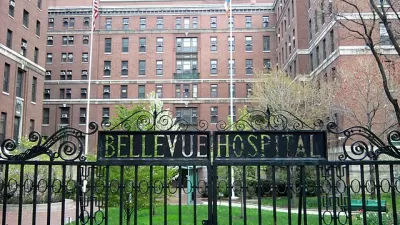With Campus Kilpatrick, Los Angeles County has made a serious investment in progressive design to support progressive programming.
At Metropolis Magazine, Thomas Musca and Emily Gardner profile a facility in Malibu they describe as “Los Angeles County’s $48 million wager on the future of youth incarceration.”
It’s Campus Kilpatrick, built on the site of the former Camp Vernon Kilpatrick, which was designed in the 1960s for the type of juvenile detention that the county would like to leave in the past.
The primary goal—and apparently, one accomplishment—of the new design is that someone incarcerated in it feels less incarcerated than they might in the average jail. It’s laid out like a small college campus, has a “cottage-style housing model,” and allows residents to wear their own clothes.
“In order to minimize the harsh visual impact of perimeter hurricane fencing, much of the campus is cordoned off by buildings. This is achieved by conjoining most of the eastern structures on site. The complex’s reception desk, waiting room, and ‘command post’ are consolidated in between administrative offices, staff housing, and the common room. While the command post has the entire campus in view, it is the anti-panopticon, ‘accountable’ to visitors by being completely visible from inside the waiting area.”
The architecture of correctional facilities is a relatively frequent topic in discussions of the ethic of design. Two years ago the AIA recently considered—then rejected—a petition that would have mandated censure for any member whose designs included areas devoted to solitary confinement or “death chambers.” A Dutch study on prison design found marked differences in the relationship between prisoners and staff, which deeply affected the experience of prisoners.
The idea behind Campus Kilpatrick, is that “state-of-the-art design supports the state-of-the-art programming.”
“This ethos informs a new ‘L.A. Model’ of youth detention that rejects a punitive, boot-camp incarceration style in favor of therapeutic support for its often traumatized occupants.”
A similar architectural approach to juvenile justice was recently finished in Marseille.
FULL STORY: Can the Design of L.A.’s New Juvenile Detention Facility Change the Future of Youth Incarceration?

Alabama: Trump Terminates Settlements for Black Communities Harmed By Raw Sewage
Trump deemed the landmark civil rights agreement “illegal DEI and environmental justice policy.”

Study: Maui’s Plan to Convert Vacation Rentals to Long-Term Housing Could Cause Nearly $1 Billion Economic Loss
The plan would reduce visitor accommodation by 25% resulting in 1,900 jobs lost.

Planetizen Federal Action Tracker
A weekly monitor of how Trump’s orders and actions are impacting planners and planning in America.

Baltimore Ordered to Improve Sidewalk Accessibility
The city is one of many to face lawsuits for failing to comply with the Americans with Disabilities Act.

This Toronto Suburb Has More Bus Riders Than Columbus, Ohio
Brampton, Ontario used gradual improvements in service to prove that if you build it, they will ride.

Paris Bike Boom Leads to Steep Drop in Air Pollution
The French city’s air quality has improved dramatically in the past 20 years, coinciding with a growth in cycling.
Urban Design for Planners 1: Software Tools
This six-course series explores essential urban design concepts using open source software and equips planners with the tools they need to participate fully in the urban design process.
Planning for Universal Design
Learn the tools for implementing Universal Design in planning regulations.
Smith Gee Studio
Alamo Area Metropolitan Planning Organization
City of Santa Clarita
Institute for Housing and Urban Development Studies (IHS)
City of Grandview
Harvard GSD Executive Education
Toledo-Lucas County Plan Commissions
Salt Lake City
NYU Wagner Graduate School of Public Service





























